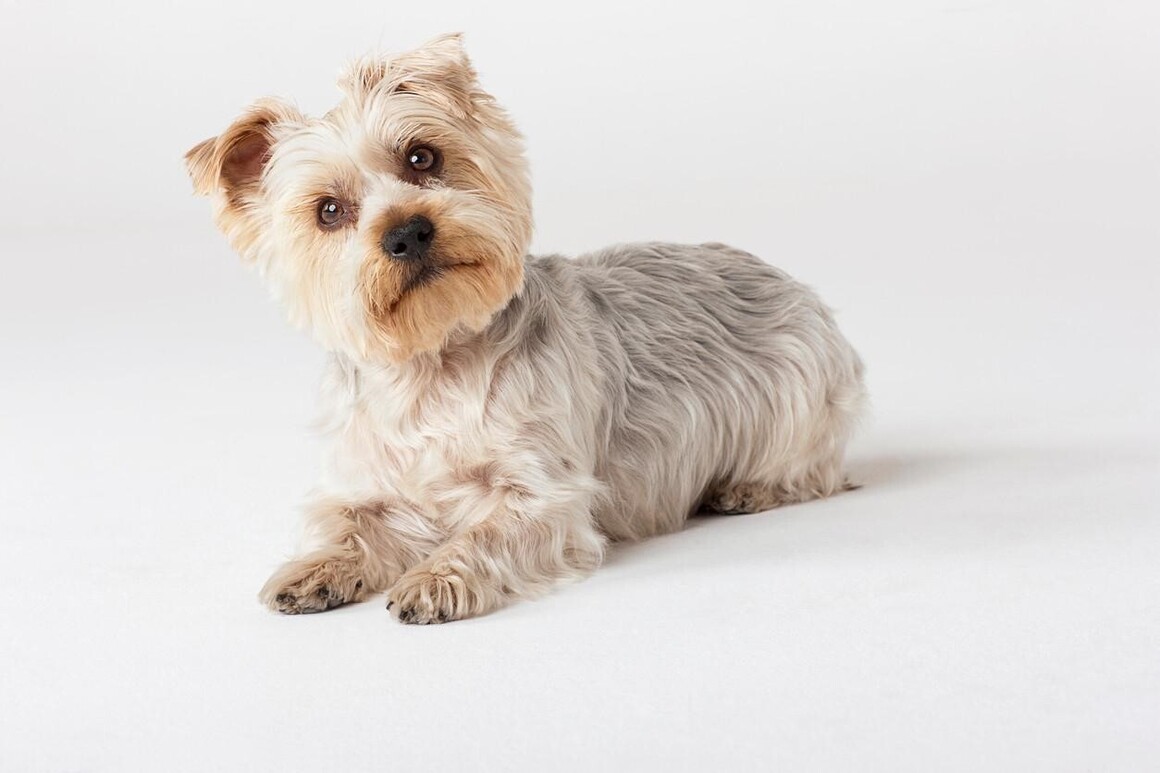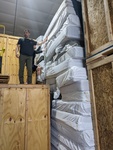Yorkshire Terriers are an elegant and compact breed, and they are loving companions and a famous dog breed in the United States. Yorkies, as they are fondly called, have won the hearts of so many and have many fans.
They are fierce, compassionate, devoted, and loyal to their owners. Yorkies are among the most glamorous representatives of the dog world. It commands attention wherever he goes, and it sometimes travels in style in special dog purses carried around by his proud owner.
With their amazing coat, compact size, and unending loyalty, it's not a surprise that they are the second most popular breed in the United States today.
>>>Take Our Quiz To Find Out Which Dog Breed Fits Your Personality Best<<<
History of the Yorkshire Terrier
In the Industrial Revolution in England, Scottish workers came into Yorkshire to work in the factories, the coal mines, and the textile mills. They brought with them a dog called a Paisley Terrier or a Clydesdale Terrier.
These dogs were larger than the Yorkies we see today. It was believed that these dogs were mainly used to catch rats in the mills. The Clydesdale Terrier were crossed with other types of terriers; the Skye Terrier, the English Black, and the Tan Toy Terrier.
The Waterside Terrier may have contributed to the development of the Yorkshire Terrier. The Waterside Terrier is a small dog with a long blue-gray coat. In 1861, Yorkies were displayed in a bench show as a "broken haired Scotch Terrier."
A dog by the name of Huddersfield Ben was born in 1865, became a popular show dog, and is believed to be the father of the modern Yorkshire Terrier. Yorkshire Terrier got that name in 1870 because that is where most of its advancement took place.
Yorkies were first registered in the British Kennel Club stud book in 1874. The first Yorkshire Terrier breed club in England was formed in 1898. The earliest record of a Yorkie being born in the United States was in 1872.
They were able to compete in dog shows in the year 1878. In these early shows, classes of Yorkshire Terriers were divided by weight- under 5 pounds and 5 pounds and over.
Ultimately, exhibitors settled on one class, with an average of between 3 and 7 pounds.
Appearance and size
Yorkies are 8 to 9 inches tall at the shoulder and weigh between 4 to 6 pounds as this is their preferred weight, but they weigh no more than 7 pounds.
They can be inconsistent in size, and it is possible for a single litter to have one Yorkie weighing less than 4 pounds, another Yorkie who weighs five or six pounds.
They have a long silky coat, it is without a single wave, and a perky topknot, their long steel blue and tan coat could just be the Yorkshire Terrier's crowning glory.
Puppies are born black. Their blue and tan coat develops gradually, which is usually after they are a year old. After a year old, puppies start to lighten and often turn gray rather than blue.
From the back of the head to the tip of the tail, their hair is dark steel blue with a bluish sheen when looked at in the sunlight. Their head is bright gold and not reddish with tan hairs that are darker at the roots than they are at the end.
The hair that falls over their face is long with the same golden color as the face. The hair at the base of the ear and at the muzzle is slightly darker. The tan on the hair doesn't go beyond the ears, and no black hair mixes with the tan. Yorkies have tan legs as well.
Grooming
The dental care of Yorkies is something that needs a lot of attention. They do not tolerate cold or heat well. They need extra care when the weather is too cold or too hot, do not take them outdoors in this condition.
Brush your Yorkie's coat every day to prevent tangles and mats also help keep him clean. They tend to have tartar buildup and bacterial in their mouth. They might also lose teeth at a young age, so brush their teeth daily and schedule a professional cleaning with your vet at least once a year.
Bath them weakly to keep their coat beautiful and shin, after wetting their coat and applying shampoo and running your fingers through it to lift the dirt out. Apply conditioner and rinse thoroughly.
Do not brush a dry or dirty coat as you'll break the hair. Trim their nails twice a month. It is a superb idea to get your pup accustomed to being brushed and accustomed to being examined and brushed when he is still a puppy.
As you from them, check for rashes, sores, signs of infection such as inflammation on the skin, in the mouth, in the nose, in the feet, and in the eyes. You should also check for redness and tenderness. Their eyes should be clear and without discharge or redness.
A weekly exam is essential to spot potential health problems at an early stage.
Temperament
Yorkies are elegant-looking dogs. His amazing personality makes him more attractive to his family. They are smart and self-assured, they are a range of personalities, some are cuddly and perky and all they want us to cuddle and follow their family all day, while some are mischievous and outgoing.
Yorkies are big dogs in a small body. Most times, they are oblivious of their small size and delicate structure. They lookout for opportunities to have an adventure or stir up a bit of trouble.
They think they are big dogs and will pick a fight with bigger dogs if allowed. They are very playful and enjoy playing with children. Older children should be taught to respect them and handle them delicately, which toddlers and small children may not understand. They can be snappish if teased or startled.
They thrive in homes where they get plenty of care, love, playtime, and attention. During the moments they play with children, be sure to supervise them as dogs should not be left alone with children, and in the case of Yorkies, they might be injured by children due to their small size. Yorkies are house dogs.
Yorkshires, like all companion dogs, are very affectionate towards people. They can be cautious and suspicious of strangers and will bark at strangers, strange sounds, and unusual smells, and they have a tendency to be yappy which may not go down well with your neighbors. Hence, they are better suited to apartment living.
They can have a bit of an aggressive side to strange dogs, pets, and no squirrel is safe from Yorkies. They are a very brave breed, and they are extremely courageous. Despite their courage, they also have a soft side as well.
It is not a good idea to leave them alone for long periods of time as they need lots of attention. Do not overprotect or over-pamper your Yorkshire. They can pick up on your feelings quickly, and if your actions make them feel like all is not well, they can become distraught.
Regardless of what home they live in, they get along with other dogs and animals, but they might get possessive the first time a new pet is brought into the house, be careful when introducing a Yorkie to a new animal.
When they sense intruders or a fight breaks out, they are willing to fight to the death to protect their families. Yorkshires are prone to chills and do not like the cold weather, especially if they are damp or in damp areas.
Health
Yorkies have a delicate digestive system and are known to be picky eaters. They can develop an eating problem if they have teeth or gum problems. If you notice your Yorkie is having discomfort when eating or after eating, do not hesitate to take him to the veterinarian for a checkup.
Yorkshire Terriers keep their teeth, especially the canines, when they are 5 months old, start checking their teeth often.
When you notice they have started to grow their adult teeth, but their baby teeth are still there, take them to the vet. Retained baby teeth can lead to the adult teeth grow unevenly and even worse, may lead to tooth decay in their later years.
Dogs of this breed have a life span of 12 to 15 years. They have a litter size of 4-6 puppies.
They are generally healthy, but there are some health conditions they fall victim to, such as; Patellar Luxation: this condition is also known as "slipped stifles," this condition is common in small dogs. This happens when the patella, which has 3 parts; the femur (thigh bone), the patella (knee cap), and the tibia (calf), is not properly aligned. This causes an abnormal gait in the dog or lameness in the leg of the dog.
Patellar luxation is a disease that is present at birth although the misalignment does not occur until much later. The rubbing caused by Patellar Luxation may lead to arthritis. Arthritis is a degenerative joint disease.
There are 4 grades of Patellar luxation ranging from grade I and occasional luxation, causing temporary lameness into a joint to grade IV. In this grade, the turning of the tibia is severe, and the patella can't be realigned manually. This gives the dog a bowlegged look. Severe grades of patellar luxation may need surgery to repair. Patellar luxation is hereditary.
Progressive Retinal Atrophy (PRA): this is a degenerative eye disorder. Blindness caused by this condition takes a while to kick in, resulting from the loss of photoreceptors in the black of the eye. It becomes detectable years before the dog begins to show any signs of blindness.
Portosystemic Shunt: this condition is also called PSS. It is an abnormal flow of blood between the liver and the body. This poses a problem as the liver is responsible for detoxifying the body, eliminating drugs, and metabolizing nutrients. Signs of this condition can include lack of appetite, hypoglycemia (low blood sugar), neurobehavioral abnormalities, urinary tract problems, drug intolerance, stunted growth, and intermittent gastrointestinal issues, etc. Corrective surgery can be helpful as well as a special diet.
Hypoglycemia: Hypoglycemia is a common condition in small breed dogs, including Yorkies; it occurs mostly when stressed, especially when they are still puppies. Hypoglycemia is caused by low blood sugar. Some signs of hypoglycemia include confusion, a wobbly gait, seizure-like episodes, weakness. If your dog shows any sign of this, you should talk to your vet about methods of prevention and treatment options.
Collapsed Trachea: The trachea which carries air to the lung can collapse easily. The most common indicator of a collapsed trachea is a recurrent dry, harsh cough that many describe as being similar to a "goose honk." This condition may be tested surgically or medically.
Reverse Sneezing: Reverse sneezing gets confused with the collapsed trachea. It is far less serious and lasts for only a few minutes. It only happens when there are irritants or pollen in the air. Secretions from the dog's nose drop onto their soft palate, causing it to close the windpipe in an automatic reaction, this can reverse your Yorkie, but as soon as he calms down, the sneezing stops. You should stoke his throat very gently to help him relax.
Training and exercise
Yorkies are famous for being difficult to house train. Crate training is recommended. Yorkies require a great amount of patience, praise, and positive reinforcement during training.
You can get them squeaky toys, but you should check the toys regularly to be sure they haven't chewed it up and taken out the squeaker. They also enjoy fetching toys.
Yorkies are one of the best pets to have in an apartment, but they can be yappy, as your neighbors might complain. If you want them in your apartment, then you have a bit of work to do. In consideration of your neighbors, you would have to teach your Yorkie when to and when not to bark to curb their excessive yapping.
They need to exercise every day, sometimes running around the living room, going for a walk, or playing a game of fetch. Every dog needs to learn socialization and grooming from a young age.
Even better, you can take your pup to obedience classes to keep him under control. If you do not set limits or you spoil your Yorkie too much, they will become mischievous and want to be in control.
You will have better luck training them when they are puppies. Yorkies enjoy taking walks or playing outside, considering they are very active while indoors. They do not require a lot of effort to keep them well exercised.
Yorkies are receptive to training, especially if they gain attention for doing cute tricks or performing in obedience and agility trials. This breed can be difficult to housetrain. They sometimes have small "accidents," it is not recommended to let these slide.
Show them from the onset where to do their business and reward them when they do it in the right place.
>>>Take Our Quiz To Find Out Which Dog Breed Fits Your Personality Best<<<
Why you should get a Yorkshire Terrier
Yorkshires give as much love as they receive. If you provide them with enormous amounts of love, care, playtime, and attention, you will find that they make an adorable, loving companion who will be loyal to you and be a wonderful addition to the family.
If you are the type to travel in style and make a fashion statement, Yorkies will help you stand out as their silky coat makes them glamorous, and their small size makes it easy to carry them about in special dog purses.
Where to get a Yorkshire Terrier and price
Despite their status as purebreds, Yorkshire Terriers may be found in the care of shelters and rescue groups.
To get a healthy puppy, do not buy from an irresponsible pet store, breeder, or puppy mill. Be sure to look for a reputable breeder who tests her breeder dogs and makes certain that they are free from genetic diseases and they have a sound temperament.
Avoid breeders who offer "teacup" Yorkshire Terriers. Dogs who are smaller than the standard Yorkie size are prone to genetic disorders and are at a higher health risk. You should expect to see health clearances for both parents.
Aubum University for Thrombopathia for VonWillebrand's doses, hypothyroidism, and elbow dysplasia
The Orthopedic Foundation for Animals (OFA) for hip dysplasia with a score of either fair or better
The Canine Eye Registry Foundation (CERF) certifying that the eyes are normal.
Health clearances prove that the dog and his parents have been tested for and cleared of certain conditions. You can verify the health clearances by checking the OFA website (offa.org). They cost between $800 and $1500.
>>>Take Our Quiz To Find Out Which Dog Breed Fits Your Personality Best<<<
Media Contact
PawsandFurs
New York City, NY
United States







